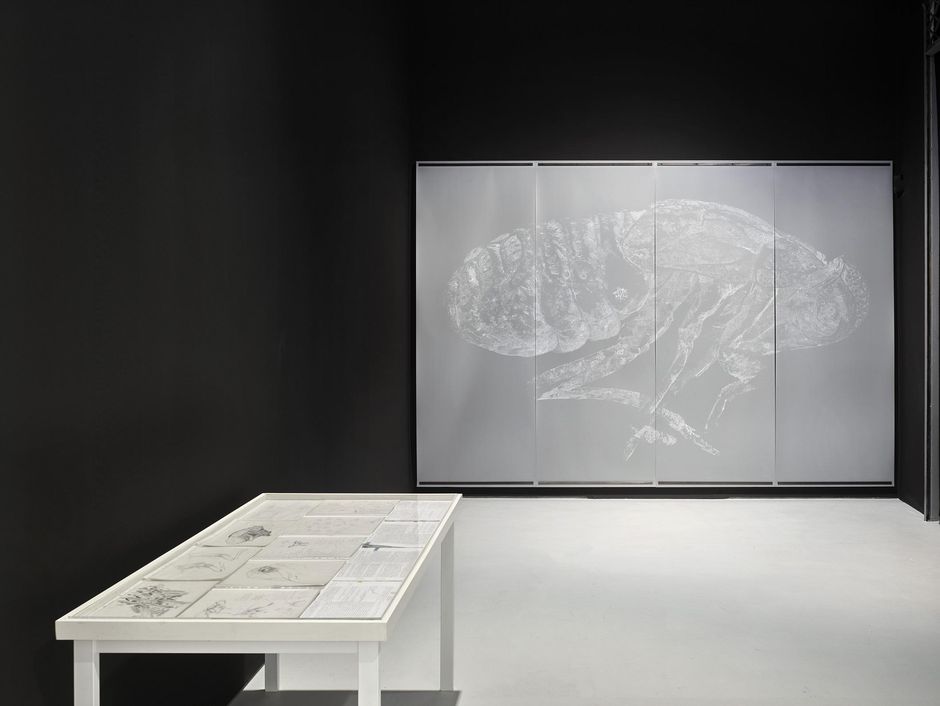
Francesco Barocco, Sandra Boeschenstein, Marsha Cottrell, Dagmara Genda, Stella Geppert, Hanna Hennenkemper, Birgit Hölmer, Veronika Holcová, Britta Lumer, Hartmut Neumann, Boryana Petkova, Oliver Thie, Sandra Vásquez de la Horra, Irene Weingartner, Nicole Wendel, Wolfgang Zach
Exhibition: March 11 to June 26, 2022
Curator: Ludwig Seyfarth
The group exhibition Gulliver’s Sketchbook takes the visitors of KAI 10 | ARTHENA FOUNDATION on an imaginary journey that follows the curiosity and fantasy of the pencil as it delves into microscopic worlds or maps the inside of the body, meticulously traces the surfaces of objects, small and large, and even engages with the distances and dimensions of the universe. In reference to Jonathan Swift’s novel Gulliver’s Travels, published in 1726, the exhibition spans an arc from the graphic recording of the outer world via filigree geometric constructions or traces and impressions of the body to the free and playful outline of surreal realms and scenarios. Here, the particular focus is on how the bodily activity of drawing relates to existing or imagined physical dimensions, also in respect to shifts in cultural-historical perspectives.
Until well into the 19th century, it was impossible to capture visual impressions and observations made on journeys or elsewhere without the drawing hand: nowadays, the shutter button of a camera is enough, more often that of a smartphone. However, in defiance of all technical upgrades, the simple gesture of picking up a pencil to put something on paper, also in its quality of a direct coordination of eyes, body and hand, has not lost the fascinating power of being at the indisputable origin of drawing. Gulliver's Sketchbook exemplifies these aspects and furthermore visualises the diversity of contemporary drawing. Yet the scale ratio of today’s globalised and instantly networked world is different from what it was in the 18th century. In view of virtual simulations that can be sent around the world in real time, real scale seems to be steadily losing importance. In addition, the designing of virtual objects or spaces primarily takes place independently from the given scale of the human body. Yet in direct drawing on paper or any other material, the body always remains present. Thus, drawing is a conscious renunciation of technological elaboration and its temporal dimension becomes a pause in the flow of images that we are constantly exposed to. Last but not least, the exhibition also raises the question as to how the process of drawing can become a means of human communication, even across distances.
Supported by

Thanks to

Images

Accompanying program
Public guided tours
Public guided tours | 3 pm: 13.03., 27.03., 10.04., 24.04., 08.05., 22.05., 12.06.2022
Publication
, 4 pm – 8 pm
Gulliver’s Sketchbook: Soft Opening
For the soft opening and for regular visits of the exhibition 3G applies respective of the Corona regulations in force.
, 7 pm
Where is drawing these days?
People were already drawing 20,000 years ago. Nevertheless, drawing still has a firm place in today's art scene. But which one? What role does drawing play in art institutions and on the art market?
Panel discussion with Joana P. R. Neves, Curator, London & Artistic Director of Drawing Now Art Fair, Paris and Jan-Philipp Frühsorge, Art Historian and Curator, Berlin / Paris, moderated by Ludwig Seyfarth, Exhibtion curator (In English).
, 7 pm
Düsseldorf’s Night of Museums
The Body as the Scale of Drawing
How does the physical activity of drawing relate to existing or fictional dimensions? In the Gulliver's Sketchbook exhibition, 16 artists driven by the ingenuity of the drawing pen pursue this and further questions. Short guided tours will take you from the microcosm to the macrocosm. In Nicole Wendel’s performance (N)ON SITE BODIES, the individual scale becomes visible in the context of physical, psychological and architectural space. In his documentary Oliarus Polyphemus, Oliver Thie describes how his artistic practice is based on the engagement with scientific imaging techniques.
7 pm, 10 pm, 11:30 pm: short guided tours of the exhibition
Nonstop: Oliarus Polyphemus, documentary by Oliver Thie on his two-year residency at the Berlin Museum of Natural History
8 pm, 9 pm: (N)ON SITE BODIES, performance by Nicole Wendel and Jan Burkhardt with eleven dancers from the University of Music and Dance in Cologne / 30 min
, 3 pm
Finissage and artist talk
Trace and Observation
Drawing as an imprint and as a response to imaging processes in the natural sciences
With: Sandra Boeschenstein, Hanna Hennenkemper, Oliver Thie and Irene Weingartner
Moderated by Ludwig Seyfarth, Exhibition curator
















